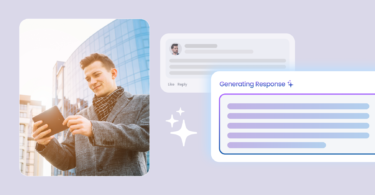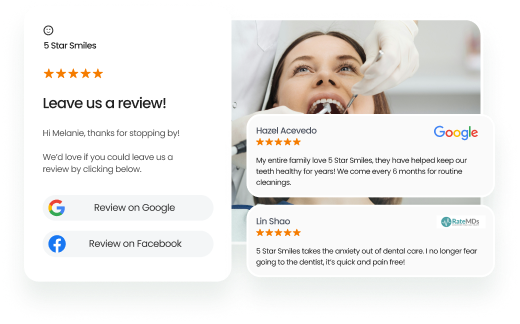Sales process automation is the difference between a sales team stuck in manual tasks and one that’s closing deals faster across hundreds of locations. For multi-location businesses, the challenge is scale. How do you route leads to the right branch, eliminate repetitive tasks, and still maintain a personalized customer experience? Traditional tools fall short, leaving sales reps juggling data entry, follow-ups, and approvals that eat into selling time.
This is where AI changes the game. By leveraging sales automation tools and software, businesses can streamline workflows, prioritize qualified leads, and empower their sales teams to focus on what they do best: building customer relationships and closing deals.
In this blog, we’ll explore exactly how AI sales automation solutions work, the benefits they unlock, and the top 10 AI-driven ways to implement them across your multi-location business.
How to automate your sales process with AI?
If you’re short on time, here’s the quick playbook to get started with AI sales automation:
1. Automate lead routing – Instantly assign leads to the correct location or sales reps based on territory, product, or availability.
2. Use AI-powered lead scoring – Identify qualified leads first so your sales teams prioritize high-value opportunities.
3. Automate follow-up emails and calls – Ensure no lead is forgotten with consistent, personalized touchpoints.
4. Capture and process customer data automatically – Reduce human error and time-consuming tasks with AI-driven data entry.
5. Generate sales reports on autopilot – Get accurate sales forecasting and performance insights without manual spreadsheets.
6. Streamline approval workflows – Cut bottlenecks in discount requests, contracts, and deal sign-offs.
7. Integrate with CRM software – Connect your automated workflows with customer relationship management tools for a unified view.
These steps demonstrate that automation software not only replaces manual tasks but also builds a more innovative, faster sales process that drives measurable results.
Table of contents
- What is sales process automation?
- How does sales process automation work?
- Benefits of sales process automation for multi-location businesses
- Connecting marketing automation and sales process automation
- Differences between CRM and sales automation
- 10 ways to use AI tools for sales process automation
- Sales process automation with AI: Implementation challenges
- How to choose the right sales automation software for your business?
- Birdeye’s Agentic AI tools for sales automation
- Conclusion
- FAQs on sales process automation
- Boost sales productivity with Birdeye’s AI agents
What is sales process automation?
Sales process automation is the use of technology, particularly AI-driven sales automation platforms, to handle repetitive tasks like data entry, follow-up emails, lead management, and reporting. Instead of sales reps spending hours on administrative tasks, the system automates these workflows to keep the sales pipeline moving.
A Salesforce study reveals that sales teams dedicate 71% of their time to non-selling tasks, while companies experience an over 40% increase in case closures with AI agents.
With sales automation, businesses can ensure:
- The sales team quickly identify potential customers and route them through the sales funnel for further nurturing
- Every brand works with accurate data and a consistent process
- Real-time visibility into the sales pipeline, customer journey, and revenue potential
How does sales process automation work?
Sales process automation is an elevated combination of automation software, CRM software, and AI-driven sales automation tools to manage every stage of the sales process. Instead of relying on manual tasks, businesses set up automated workflows that trigger specific actions based on customer behavior, lead status, or pipeline stage.
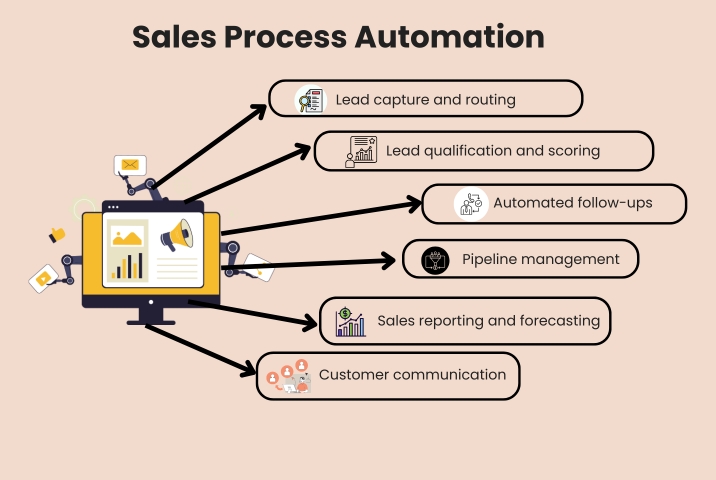
Here’s a step-by-step breakdown of sales automation:
- Lead capture and routing – Customer data from web forms, ads, or calls is automatically captured and assigned to the right sales reps.
- Lead qualification and scoring – AI evaluates potential customers, ranking them based on buying intent and fit, so sales teams prioritize qualified leads.
- Automated follow-ups – The system sends follow-up emails and proactively schedules sales calls, ensuring no opportunity is lost.
- Pipeline management – Each stage of the sales funnel is tracked in real time, helping sales leaders monitor progress.
- Sales reporting and forecasting – Automated sales analysis gives insights into performance, generating accurate data for sales forecasting and planning.
- Customer communication – From onboarding to reminders, AI-powered workflows maintain consistent customer interactions across all locations.
Think of it as your virtual assistant for the sales journey: it reduces human error, eliminates repetitive sales tasks, and keeps your sales professionals focused on closing deals. For multi-location businesses, this consistency is critical, whether you’re managing three branches or three hundred.
Benefits of sales process automation for multi-location businesses
Adopting sales process automation unlocks a set of advantages that directly impact sales productivity, customer experience, and long-term growth for multi-location businesses. Let’s break down the core benefits of sales automation and why they matter.
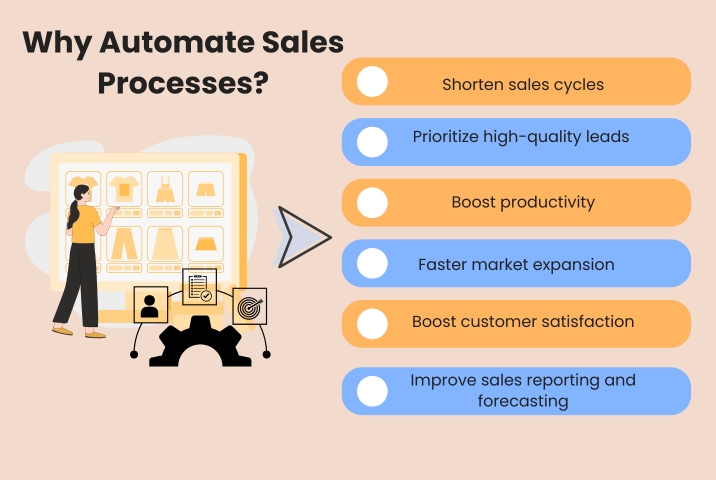
Shorten sales cycles
When sales automation tools handle follow-up emails, data entry, and pipeline management, sales reps spend less time on administrative tasks and more time closing deals. Automated reminders and workflow automation reduce delays, ensuring leads move smoothly throughout the sales cycle.
Choose high-quality leads on priority
AI-driven sales automation software prioritizes qualified leads by analyzing customer data and intent signals. This helps sales teams focus on opportunities that have a higher chance of converting, leading to more efficient use of sales resources and higher win rates.
Boost productivity
By automating repetitive sales tasks like lead management and sales reports, businesses eliminate manual tasks that consume hours daily. This boosts sales productivity, allowing sales representatives to spend more time engaging in meaningful customer interactions that strengthen customer relationships.
Faster market expansion
With automation software managing approval workflows, customer communication, and reporting, businesses can replicate successful sales processes across multiple locations. This consistency enables sales managers to scale into new markets more quickly without overwhelming existing sales teams.
Boost customer satisfaction
A streamlined sales process means fewer missed follow-ups, quicker responses, and more accurate data. Customers feel valued through timely communications, leading to stronger customer experiences and long-term loyalty across every location.
Improve sales reporting and forecasting
AI-driven automated sales analysis and forecasting provide sales leaders with accurate data. Instead of depending on spreadsheets or manual reports, managers can access real-time insights for accurate sales forecasting and smarter decision-making.
Sales automation can exist alone but works 100x better when combined with marketing and CRM tools. Let us take a look at how that works.
Connecting marketing automation and sales process automation
Marketing automation and sales process automation are often seen as separate functions, but the real impact comes when businesses integrate both the processes to work hand in hand. For multi-location brands, aligning the two creates a seamless customer journey, from awareness to conversion.
Marketing automation nurtures potential customers through campaigns, emails, and ads, while sales automation tools ensure those leads are captured, scored, and routed to the right sales reps at the right time.
When the two systems integrate, marketing teams and sales teams share up-to-date data on customer interactions, reducing silos and improving lead management.
Here’s what happens when the sales automation technology integrates with marketing automation:
- Leads generated by marketing campaigns flow directly into the sales pipeline without manual tasks or delays.
- Automated follow-up emails and reminders reduce drop-offs in the lead generation process.
- Accurate data supports both sales forecasting and marketing campaign optimization.
- Sales managers gain visibility into how marketing contributes to closing deals, helping align sales targets with campaign strategy.
Differences between CRM and sales automation
It’s easy to confuse CRM software with sales automation software, since both manage customer data and interactions. But their roles are distinct:
- CRM software is primarily a customer relationship management tool. It stores customer information, tracks communication history, and provides a central hub for sales teams to manage relationships. Think of it as the digital filing system that keeps everything organized.
- Sales automation solutions, on the other hand, are designed to automate repetitive tasks such as follow-up emails, data entry, sales reports, and pipeline management. These tools reduce time-consuming tasks, improve sales productivity, and ensure sales reps focus on qualified leads.
CRM is about managing relationships, while sales automation platforms are about streamlining the sales process. When combined, they create a robust ecosystem where customer interactions are both personalized and efficient, giving sales professionals the best chance to succeed.
10 ways to use AI tools for sales process automation
AI-powered sales automation tools reshape how multi-location businesses run their sales process. They align sales, marketing, and operations to drive growth across locations. Here’s how different types of automation work in practice.
Here are 10 ways to elevate your sales process automation with AI.
Lead routing automation
Generating leads is just the beginning; the magic happens when the lead immediately gets a message from the sales team to strike while the iron is hot.
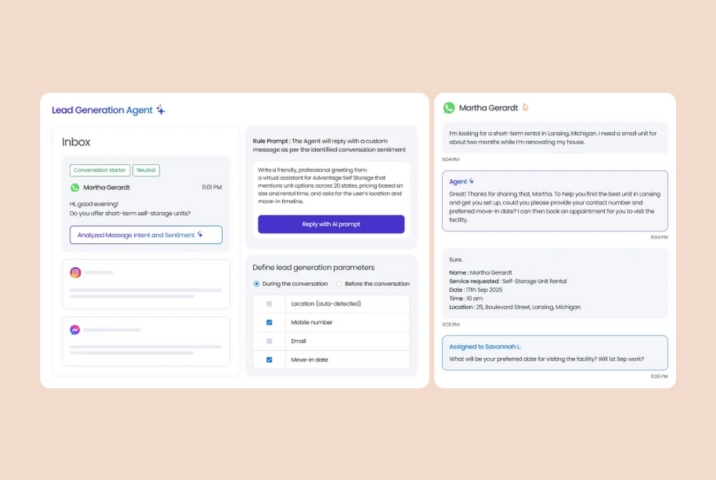
AI tools elevate lead routing in sales automation processes since they can:
- Instantly assign new leads from web forms, phone calls, or ads to the right sales reps based on geography, product knowledge, or workload.
- Ensure no potential customer is left waiting or allowed to move on to a competitor
- Local branches don’t lose leads due to mismanagement
- Integrate with CRM software and marketing automation platforms to keep the sales pipeline flowing smoothly.
Automated lead scoring
The 80-20 rule isn’t just a suggestion in sales; your sales team must focus on high-potential leads rather than chasing accounts that will inevitably ghost you. But knowing which leads to pursue can be a significant challenge for large enterprises.
Here is how automating sales with AI tools can change that:
- AI evaluates customer data, from demographics to digital behavior, and assigns a score to each prospect. This helps sales teams prioritize qualified leads that are more likely to buy, instead of wasting effort on low-value prospects.
- Lead scoring feeds directly into campaign targeting for marketing teams, ensuring alignment between marketing spend and sales performance across multiple locations.
Cold emails and call outreach automation
Cold calling, sending emails without expecting a response, and trying to spark a connection are all huge parts of sales. However, this part does not always directly yield revenue; it is part of the bigger picture.
And without automation, your sales team can get stuck in a cycle of cold outreach and lose motivation to actually work on leads that would convert.
Automating your cold outreach with AI ensures:
- AI tools schedule personalized outreach campaigns, automatically sending follow-up emails and reminders, while also placing sales calls at optimal times
- Your team saves hours of repetitive tasks while improving consistency
- Every lead receives timely communication, not just those a rep remembers to contact.
- Each branch maintains consistent messaging, with personalization powered by customer relationship management systems.
Timely customer interactions dramatically increase conversion rates. Missed follow-ups, common in busy multi-location operations, become a thing of the past. This bridges the gap between marketing and sales, ensuring that no lead generated by campaigns is wasted.
Customer data capture and processing
Accurate customer data ensures you never lose an important contact and can accurately track marketing campaigns with engaged leads.
Instead of manual data entry, AI pulls customer details from web forms, emails, or chats and logs them into the CRM. This reduces human error, keeps up-to-date data accessible, and frees sales professionals from time-consuming tasks.
Clean, accurate data strengthens sales forecasting, campaign personalization, and even compliance reporting across locations.
Sales report generation and management
Tracking cold leads, engaged leads, and the sales pipeline is necessary, and doing it manually can be error-prone and time-consuming, especially if you have a multi-location enterprise. There is an over-reliance on self-reporting and manager follow-ups that can interrupt the actual selling process.
AI compiles sales reports from multiple branches, presenting performance insights in dashboards without any manual effort. Sales managers and leaders gain visibility into real-time performance, helping them set accurate sales targets and coach sales representatives.
AI tools also review sales data, historical trends, and external factors to generate accurate sales forecasting. This gives sales leaders reliable predictions, helping them allocate resources effectively.
Customer communication automation
Customers need to feel engaged and essential throughout the sales process, not just when they are about to sign on the dotted line. But managing hundreds of customers without delays is not a practical possibility for every sales executive. And that is where AI tools can step in.
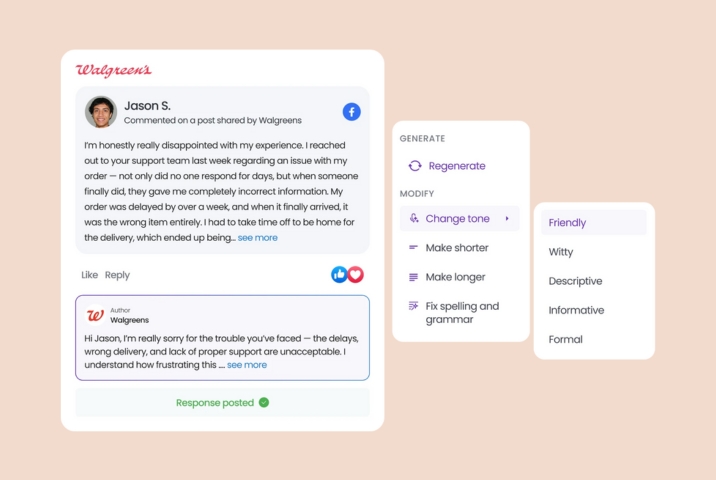
From appointment confirmations to renewal reminders, AI automates every stage of the customer journey. Consistent communication boosts satisfaction and loyalty. Customers feel valued, whether they’re engaging with a flagship store or a small branch.
Lead generation cycle automation
AI nurtures leads from first contact through the lead generation process, automating touchpoints like drip campaigns, retargeting ads, and call scheduling. It helps sales teams close deals faster by reducing drop-offs in the sales funnel.
And this ensures that enterprise businesses can focus on building stronger connections across locations and be assured that the lead is getting the right messaging at all times.
Approval workflow management
Delays in approvals stall deals. Automation keeps negotiations moving and shortens the sales cycle. AI routes discount requests, contract approvals, and pricing exceptions to managers instantly, instead of relying on emails and manual sign-offs.
For multi-location businesses, this keeps approval processes consistent across branches, ensuring compliance without slowing down growth.
Social media scheduling automation
Social presence feeds directly into lead generation, keeping the top of the funnel active. AI tools like Birdeye Social AI can schedule posts, monitor engagement, and even auto-replies with on-brand messages.
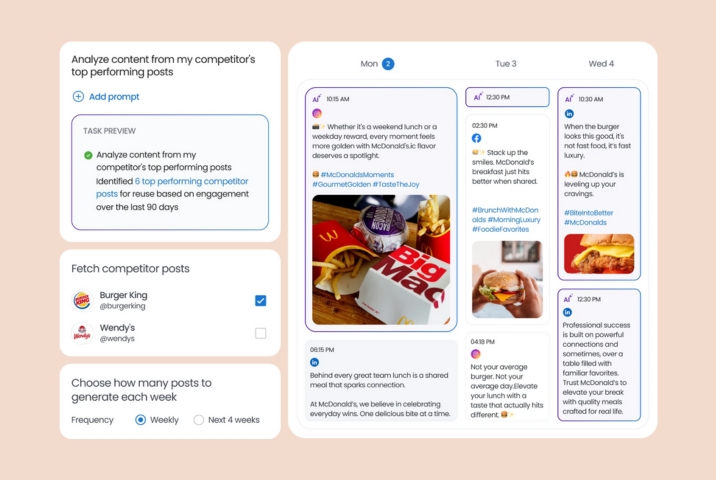
By connecting to sales automation platforms, social media activity can be tracked as part of the overall sales journey, connecting brand engagement to measurable revenue outcomes.
Sales process automation with AI: Implementation challenges
While sales automation tools offer clear benefits, implementing them across a multi-location business comes with challenges. Leaders need to anticipate these and plan for smooth adoption.
Staff training
Without proper onboarding, staff may resist change or misuse the platform, leading to poor adoption rates. Sales reps, managers, and marketing teams must adapt to new systems that replace manual tasks with AI-driven workflows. Training ensures they understand how to use automation features effectively.
Ongoing education builds confidence among sales professionals, ensuring they use automation software to its full potential and maintain consistent performance across locations.
Identifying the right tool for your business
Not all sales automation software is created equal. Choosing the wrong tool can create silos or increase costs without boosting productivity. Businesses must evaluate sales automation platforms for integration options, scalability, and usability.
The best sales automation tools seamlessly tie into CRM software, marketing automation, and ERP systems, creating a connected workflow across every branch.
Compliance and regulatory challenges
Automation relies heavily on customer data, and businesses must ensure compliance with privacy regulations like GDPR. Mishandling data can damage customer relationships and lead to penalties.
For multi-location businesses, compliance is even more critical since different regions may follow different rules. AI-driven automation features should include built-in safeguards to protect customer experience and trust.
How to choose the right sales automation software for your business?
Selecting the right sales automation software is one of the most critical decisions for multi-location businesses. The right choice can accelerate growth and simplify operations, while the wrong one can create more manual tasks and siloed processes. Here are the steps to guide your evaluation.
Set your objectives
Before exploring sales automation platforms, define what you want to achieve. Do you want to shorten the sales cycle, improve sales productivity, or align marketing automation with sales? Clear goals help you identify the right automation features and avoid tool overload.
Choose the appropriate budget
Costs for automation software vary widely—factor in not just licensing fees but also setup, training, and potential add-ons. For multi-location businesses, ensure pricing supports scaling without hidden costs for additional users or branches.
Analyze integration possibilities
Look for solutions that integrate smoothly with your existing CRM software, marketing automation systems, and ERP tools. The best sales automation tools prevent data silos by ensuring all departments — from sales reps to marketing teams share accurate, up-to-date data.
Understand training requirements
Even the most intuitive automation tools require onboarding. Assess how much training your sales teams and sales managers will need, and whether the vendor offers ongoing support. This ensures your sales professionals can adopt the platform quickly and use it effectively.
Check compliance, data security, and privacy requirements
AI-driven sales automation solutions rely heavily on customer data. Verify that the software has safeguards for compliance, encryption, and access controls. For multi-location operations, compliance should be built into workflows to protect both the customer experience and brand reputation.
Automate your sales cycle with Birdeye’s AI agents
Want to see the impact of Birdeye on your business? Watch the Free Demo Now.
Birdeye’s Agentic AI tools for sales automation
Birdeye’s purpose-built AI agents help multi-location businesses automate repetitive tasks, scale faster, and deliver consistent customer experiences.
Birdeye’s Agentic AI is the first purpose-built system designed for multi-location sales and marketing automation. Unlike generic automation tools, these AI agents are trained with industry-specific data, ensuring compliance, consistency, and measurable growth across every branch.
Here’s how you can elevate sales automation across locations with Birdeye’s AI agents:
Automating lead generation
Birdeye’s Lead Generation Agent captures, qualifies, and routes leads instantly. For multi-location businesses, this means every inquiry, whether from a web form, ad, or phone call, is automatically directed to the right branch or sales rep.

This reduces leakage in the sales funnel and ensures that sales teams can focus on qualified leads rather than chasing unverified prospects.
Automating social media management

The Social Publishing Agent and Social Engagement Agent handle posting, scheduling, and engagement at scale. For sales teams, this ensures consistent brand presence across every location and creates a steady flow of inbound leads.
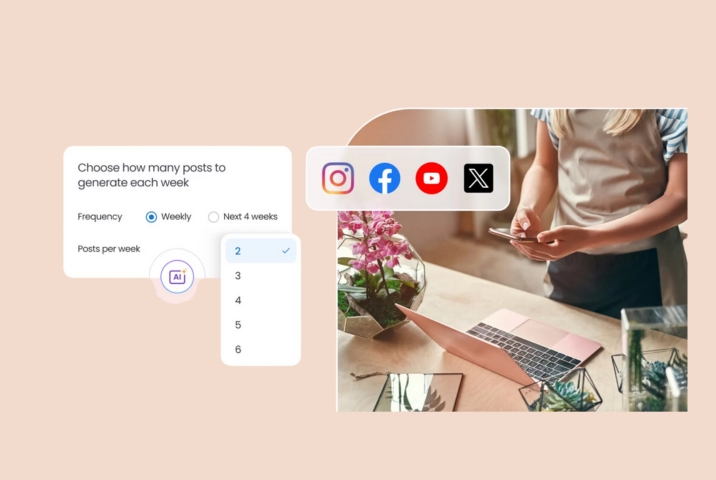
By tying engagement insights into the sales pipeline, reps gain visibility into which campaigns generate the most conversions.
Automating customer communication

Birdeye’s Email Template Design Agent and Contact Segmentation Agent simplify outreach. They generate personalized follow-up emails and campaigns for different customer segments, ensuring prospects receive timely communication.
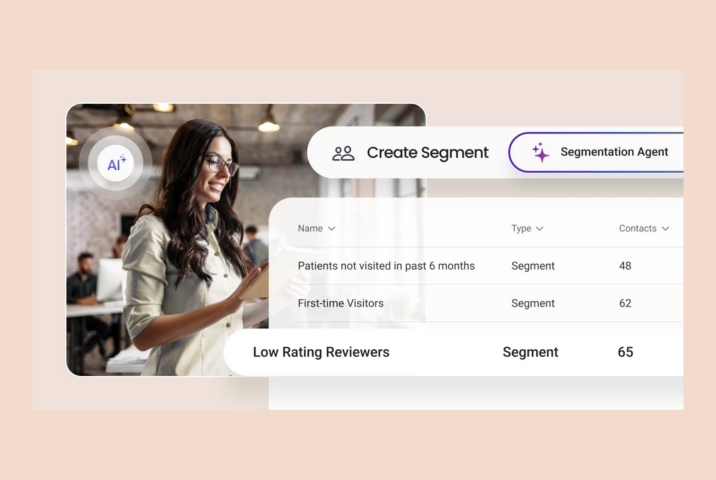
This automation reduces manual tasks, speeds up the sales cycle, and strengthens customer relationships.
Automating reputation management
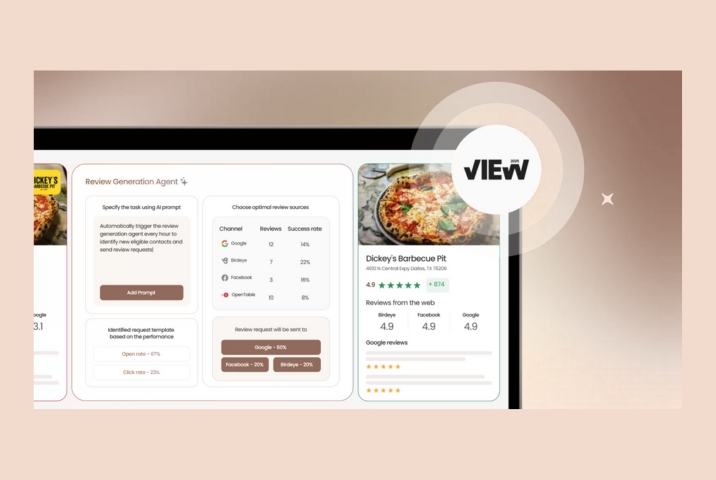
With the AI Review Response Generation Agent and Local Listings Optimization Agent, Birdeye helps businesses respond to reviews at scale and keep listings accurate across locations.
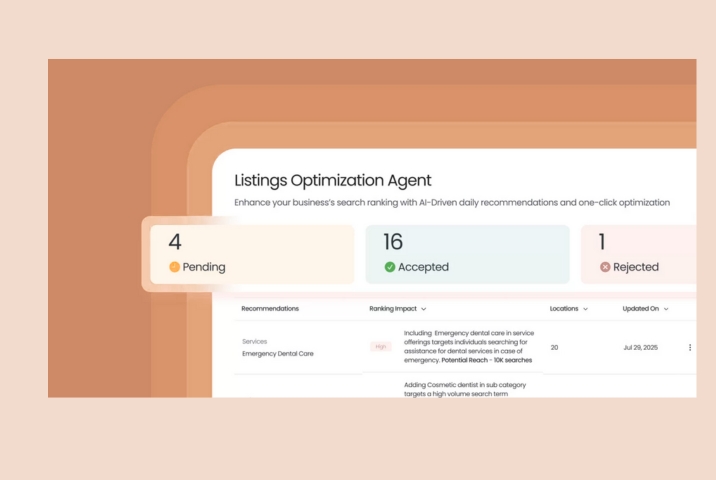
Reputation signals feed directly into lead generation, as stronger online visibility and timely review responses attract more potential customers to the top of the funnel.
Conclusion
Sales process automation is more than just eliminating manual tasks, it’s about giving your sales teams the ability to focus on building customer relationships and closing deals. For multi-location businesses, it brings consistency across every branch, ensures customer data stays accurate, and aligns marketing automation with sales.
From lead routing automation to sales forecasting automation, the right mix of sales automation tools can transform how you manage the sales pipeline and accelerate growth. By planning for challenges, choosing the best sales automation tools, and training staff effectively, businesses can unlock measurable gains in sales productivity, customer experience, and ROI.
FAQs on sales process automation
It involves the use of automation software and AI to manage repetitive tasks, such as data entry, follow-up emails, and reporting. It helps sales reps focus on qualified leads and closing deals.
Sales prospecting, lead qualification, needs assessment, presentation, handling objections, closing, and follow-up. With sales automation, many of these steps can be streamlined for efficiency.
SFA stands for Sales Force Automation, which refers to using sales automation technology to streamline tasks, manage customer data, and improve productivity.
An example is automated lead scoring, where AI evaluates potential customers and assigns them a score so sales reps know who to prioritize.
The benefits of sales automation include shorter sales cycles, improved sales forecasting, and consistent customer interactions across all branches, helping sales managers scale faster.
Boost sales productivity with Birdeye’s AI agents
Birdeye is an AI company built for multi-location businesses. Its GenAI-powered sales automation solutions go beyond standard automated sales CRM software to deliver real results:
- AI-driven lead management: Route, score, and prioritize leads automatically across every branch.
- Integrated sales and marketing automation: Align marketing teams and sales professionals with a single platform that reduces repetitive tasks.
- Automated workflows: From follow-up emails to sales reports, Birdeye removes bottlenecks and gives sales representatives more time for customer interactions.
- Insights and forecasting: Use automated sales analysis for accurate sales forecasting and decision-making.
- Scalable for growth: Whether you manage 3 or 300 locations, Birdeye’s sales automation software ensures consistent workflows, compliance, and customer experiences.
With Birdeye’s AI agents, multi-location businesses no longer need to juggle disconnected sales automation tools. Instead, they can rely on one connected system that powers the entire sales journey, from lead generation to customer communication.
Ready to empower your sales teams with automation? Request a demo with Birdeye today.

Originally published



